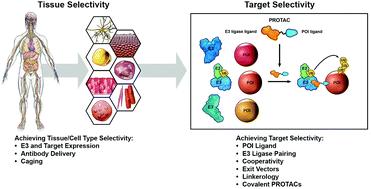Target and tissue selectivity of PROTAC degraders
Abstract
Targeted protein degradation (TPD) strategies have revolutionized how scientists tackle challenging protein targets deemed undruggable with traditional small molecule inhibitors. Many promising campaigns to inhibit proteins have failed due to factors surrounding inhibition selectivity and targeting of compounds to specific tissues and cell types. One of the major improvements that PROTAC (proteolysis targeting chimera) and molecular glue technology can exert is highly selective control of target inhibition. Multiple studies have shown that PROTACs can gain selectivity for their protein targets beyond that of their parent ligands via optimization of linker length and stabilization of ternary complexes. Due to the bifunctional nature of PROTACs, the tissue selective nature of E3 ligases can be exploited to uncover novel targeting mechanisms. In this review, we provide critical analysis of the recent progress towards making selective PROTAC molecules and new PROTAC technologies that will continue to push the boundaries of achieving selectivity. These efforts have wide implications in the future of treating disease as they will broaden the possible targets that can be addressed by small molecules, like undruggable proteins or broadly active targets that would benefit from degradation in specific tissue types.

- This article is part of the themed collection: Modalities of induced proximity pharmacology: Degraders and Beyond themed collection


 Please wait while we load your content...
Please wait while we load your content...